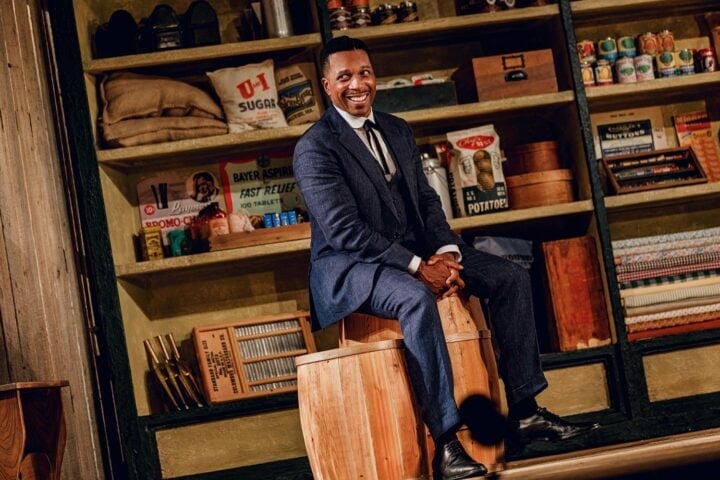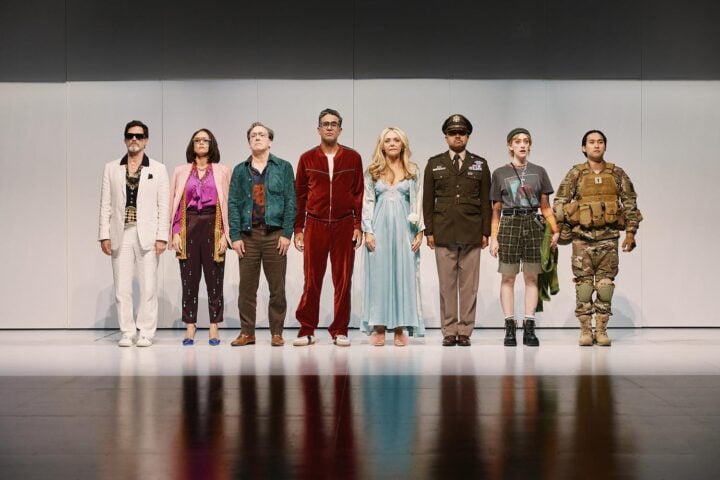Druid Theatre Company’s presentation of Sean O’Casey’s century-old Dublin Trilogy begins with a knocking. At the start of this six-hour, tripartite production dubbed DruidO’Casey, a man raps loudly on a wall, presaging the moments across the plays in which characters bang and hammer on each other’s doors, often barging in without receiving a response. And if that’s just life in Dublin’s tenements, it’s also the pounding fist of history itself demanding an entrance: In the aftermath of seismic events in Ireland’s journey toward independence, O’Casey boldly forced audiences to consider the impact of the just-concluded revolution on the everyday citizens, especially women, who become collateral damage.
At the NYU Skirball Center, the three plays of the Dublin Trilogy can be experienced individually or, on DruidO’Casey’s marathon days, all at once. The trilogy, ordered here by the historical events that the plays depict instead of O’Casey’s writing order, spans the brief and bloody unsuccessful Easter Rising of 1916 (The Plough and the Stars), the Irish War of Independence that ended with the ratification of the Anglo-Irish Treaty in 1921 (The Shadow of a Gunman), and the civil war that followed the next year as pro-Republic comrades-in-arms turned against each other in charting a path for Ireland’s future (Juno and the Paycock).
The vitality of these plays lives in the immediacy of O’Casey’s storytelling. The Shadow of a Gunman, the earliest work, which takes place in 1920, premiered at Dublin’s Abbey Theatre only three years later. Audiences today can recognize the potency of committing the recent past to the historical record only a few blocks from the Skirball Center at the Audible Theater, where Rebecca Gilman’s Swing State currently charts the political and social fallout of the pandemic on working-class Wisconsinites. And for O’Casey in the 1920s, in particular, with his satirical challenges to the common narrative about the glories of revolution, a retelling of his audiences’ shared experiences could be dangerous: The premiere of The Plough and the Stars, which most explicitly expresses O’Casey’s cynical view that the idealistic fight for independence would do little to improve conditions for the impoverished residents of Dublin’s tenements, led to a riot.
But accessing the incendiary potential of O’Casey’s storytelling here and now becomes more of an intellectual exercise in this iteration. DruidO’Casey affords us an opportunity to try and imagine what Dubliners must have felt encountering O’Casey’s groundbreaking working-class characters, but that’s not quite a substitute for experiencing that stirring energy ourselves. And Garry Hynes, who co-founded the Druid Theatre Company as a 22-year-old in 1975, stages the two longer plays with a languorous tempo, as if the entire enterprise is pacing itself for a long day. Yes, the three works in a row are a marathon, but it needn’t feel that way from the start.
The Plough and the Stars, the longest and most tonally complex of the plays, catches fire only in its final scene. The central plot is startlingly simple: Newlywed Nora Clitheroe (Sophie Lenglinger) tries desperately to keep her Republican husband, Jack (Liam Heslin), out of combat, but the tidal wave of nationalist self-sacrifice is too strong to keep the family together. Most of the play’s action, which verges on slapstick for some of its running time, centers instead on the feuds and catfights among the Clitheroes’ tenement neighbors, including Nora’s irascible uncle (Bosco Hogan), the alcoholic carpenter Fluther Good (Aaron Monaghan, who plays a similar role in Juno and the Paycock), and the caustic Protestant Bessie Burgess (Hilda Fay).
The extended second scene, largely lifted from an unproduced one-act, takes place inside a bar—throughout the trilogy, the sequences of drunken jawing don’t make the accents, already challenging for an American ear, any clearer—and is flat, its physical farce landing only in broad strokes rather than emerging from specificities of character. But the transformation of Bessie, who shifts from nagging Nora to nursing her, more powerfully grounds the final sequence, as the British soldiers terrifyingly close in, making little distinction between soldier and civilian.
Fay does double duty as another mother caught in the crosshairs of history as Juno and the Paycock’s title character. The possibility of an escape from the tenements dangles alluringly in front of the Boyle family when Captain Jack (Rory Nolan) discovers a cousin has apparently bequeathed him a small fortune. But O’Casey puts Juno through a litany of Job-like sufferings before granting her the strength to see her dead-end marriage to Jack with clarity. If, in its post-Independence setting, the play seems the least acutely political of the trilogy, it’s also the most devastating in how violently it ultimately reminds us of the Irish inseparability of humanity from political positionality: that to exist in 1922 Ireland is to choose a side.
But neither the play’s grim conclusion, with its faint flickers of hope, nor its early comic gestures fully permeate the staging’s emotional distance. With the exception of the vibrant Shadow of a Gunman, Hynes’s direction tends to be big on sweep and light on detail. Too often, lengthy scenes proceed with characters standing in more or less a straight line. And the gray-stained panels of Francis O’Connor’s set, which cluster and crowd to create three different tenements across the plays, drably gesture toward the despair of these homes without commenting on it. (The brief, buoyant musical compositions, by Conor Linehan, set a delightfully quirky tone, often unmatched by the rest of the production.) As much as O’Casey dedicated himself to amplifying the unheard voices of Dublin’s poor, DruidO’Casey often allows too many of the characters to recess back into the masses, their individual desires and dramas growing muddy.
The fortunate exception is the crackling 90 minutes at the trilogy’s center. Despite being his earliest produced work, The Shadow of a Gunman registers as more bracingly contemporary than the later plays in the trilogy, its unshakeable dark humor anticipating—and, no doubt, influencing—the plays of Ireland’s most well-known living playwright, Martin McDonagh.
And the Druid production features the crispest, grimly funniest lead performances of the trilogy from Marty Rea as a florid poet lionized by his neighbors who mistakenly believe him to be a republican gunman on the run; Caitríona Ennis as his smitten devotee, leaping over furniture to profess her interest; and Nolan (in impressive contrast to his cantankerous turn in Juno and the Paycock) as an anxious peddlar who inadvertently brings tragedy thundering down upon the tenement in the play’s effectively slow-burning denouement.
That last character, Seumas Shields, also seems to speak most potently with the voice of the playwright. “I believe in the freedom of Ireland,” he explains at one point, “but I draw the line when I hear the gunmen blowin’ about dyin’ for the people, when it’s the people that are dyin’ for the gunmen!” Though DruidO’Casey fully communicates O’Casey’s deadly satirical edge only in the shortest play on offer, his trilogy resurfaces at a moment in which his clear-eyed depiction of the incursion of war on the lives of the innocent shudders with timeliness.
DruidO’Casey runs through October 14 at NYU Skirball.
Since 2001, we've brought you uncompromising, candid takes on the world of film, music, television, video games, theater, and more. Independently owned and operated publications like Slant have been hit hard in recent years, but we’re committed to keeping our content free and accessible—meaning no paywalls or fees.
If you like what we do, please consider subscribing to our Patreon or making a donation.



